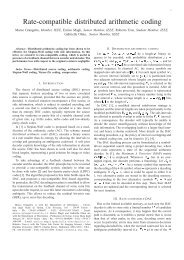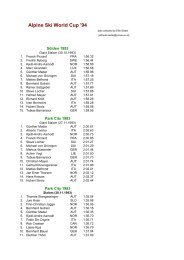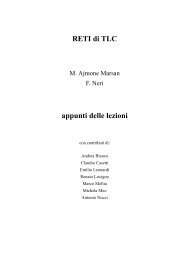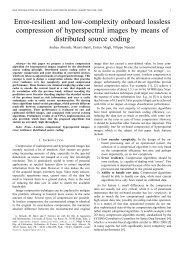Transform coding techniques for lossy hyperspectral data compression
Transform coding techniques for lossy hyperspectral data compression
Transform coding techniques for lossy hyperspectral data compression
Create successful ePaper yourself
Turn your PDF publications into a flip-book with our unique Google optimized e-Paper software.
IEEE TRANSACTIONS ON GEOSCIENCE AND REMOTE SENSING (SUBMITTED DEC. 2005) 23<br />
90<br />
85<br />
80<br />
PSNR (dB)<br />
75<br />
70<br />
65<br />
60<br />
Full−complexity KLT + JPEG 2000<br />
Low−complexity KLT ( ρ= 0.01) + JPEG 2000<br />
DWT1D + JPEG 2000<br />
3D−SPIHT<br />
55<br />
0 0.5 1 1.5 2 2.5<br />
rate ( bpp)<br />
Fig. 13. Per<strong>for</strong>mance evaluation of the proposed JPEG 2000 based technique: rate-distortion curve <strong>for</strong> the Cuprite<br />
scene. Dashed: Full-complexity KLT. Solid: low-complexity KLT, ρ = 0.01. Dotted+star: DWT1D2D as proposed in<br />
[16]. Solid+star: 3D-SPIHT.<br />
and SPECK are compared; note that, in the table, results are given in terms of signal-to-noise ratio<br />
(SNR) rather than PSNR.<br />
Consistently with the results reported above, also on the reflectance <strong>data</strong> the per<strong>for</strong>mance loss of<br />
the low-complexity KLT with respect to the full-complexity one does not exceed 0.5 dB. The lowcomplexity<br />
KLT has a gain of about 7 dB with respect to the scheme in [16] employing the hybrid<br />
rectangular/square DWT, even though <strong>for</strong> high bit-rate the per<strong>for</strong>mance gap decreases. The proposed<br />
scheme exhibits a significant gain also with respect to SPECK; the SNR gain is even more remarkable,<br />
ranging from 5 to more than 10 dB. This gain is mainly due to two factors. The <strong>for</strong>mer is the improved<br />
<strong>coding</strong> efficiency of the KLT with respect to the spectral DWPT employd in SPECK. The latter is<br />
the 3D post-<strong>compression</strong> rate-distortion optimization, which is more flexible in selecting the portions<br />
of the 3D set of trans<strong>for</strong>m coefficients that contribute more significantly to the reconstructed image<br />
quality.<br />
C. Impact on image exploitation<br />
As is well-known, quality metrics such as PSNR, which are based on the MSE, measure the<br />
fidelity of the reconstructed image with respect to the original image. However, higher PSNR may not<br />
necessarily yield higher quality of a remote sensing <strong>lossy</strong>-compressed image <strong>for</strong> a given application.<br />
In fact, some artifacts, e.g. tiling, which may have little effect on PSNR, could heavily bias the






